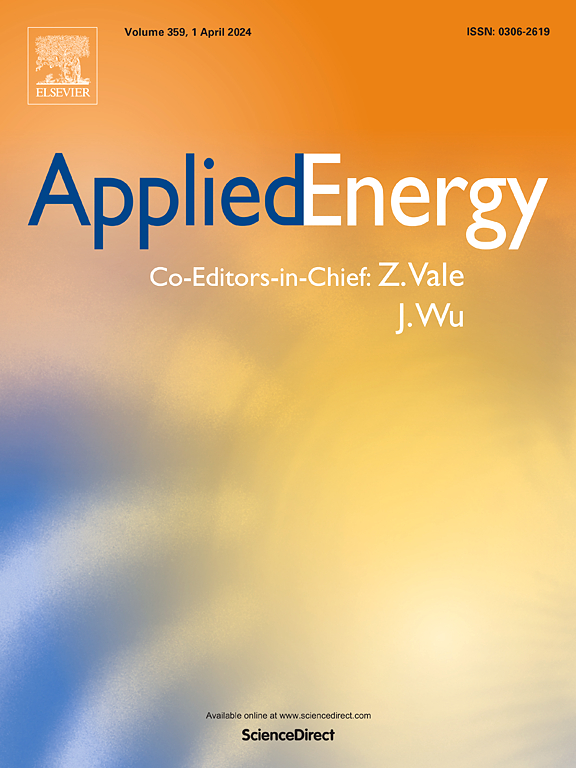Risk-averse transactions optimization strategy for building users participating in incentive-based demand response programs
IF 10.1
1区 工程技术
Q1 ENERGY & FUELS
引用次数: 0
Abstract
By participating in demand response programs, building users can provide energy flexibility for the power grid while earning economic benefits for themselves. However, the win-win situation described above is often challenged by the presence of ineffective demand response, over-target demand response and under-target demand response, which pose risks to the economic returns of building users and the stable operation of the grid. To this end, this study proposes a risk-averse transaction optimization strategy to offer bidding schemes and operational strategies that effectively balance the effectiveness of demand response with operational economic benefits. First, a novel model for calculating incentive subsidy is developed, which takes into account the power grid's requirements for demand response effectiveness, as well as differentiated subsidy and penalty mechanisms. Then, a risk-averse optimal dispatch model for building integrated energy systems is established. By collaboratively optimizing the declared response quantity and operation strategies, this method reduces the risk of incentive subsidy loss faced by building users and enhances demand response effectiveness. Lastly, the proposed models are applied in the power market of Shenzhen, China, and the effectiveness of the method is assessed based on three key performance indicators: incentive subsidy loss rate, operating cost reduction rate, the actual load response rate. The results indicate that the total incentive subsidy loss rate is reduced from 37.16 % to 17.75 % through the application of the risk-averse optimal dispatch model proposed in this paper, with operating cost savings ranging from 3 % to 8.09 %. More importantly, the effectiveness of demand response is significantly improved, with the proportion of effective response duration increasing from 18.60 % to 65.93 %. The proposed method is further validated by adjusting the penalty coefficient. Findings show that the risk-averse method provides more robust results and provides more reliable bidding schemes for declared response quantity.
建筑用户参与基于激励的需求响应方案的风险规避交易优化策略
通过参与需求响应计划,建筑用户可以为电网提供能源灵活性,同时为自己获得经济效益。然而,需求响应无效、需求响应过目标和需求响应过目标的情况往往会挑战上述双赢局面,给建筑用户的经济回报和电网的稳定运行带来风险。为此,本研究提出了一种风险规避交易优化策略,以提供有效平衡需求响应有效性与运行经济效益的投标方案和运行策略。首先,建立了一种新的激励补贴计算模型,该模型考虑了电网对需求响应有效性的要求,并考虑了不同的补贴和惩罚机制。然后,建立了建筑综合能源系统的风险规避最优调度模型。该方法通过对申报响应量和运行策略的协同优化,降低了建网用户面临的激励补贴损失风险,提高了需求响应有效性。最后,将该模型应用于深圳电力市场,并基于激励补贴损失率、运行成本降低率和实际负荷响应率三个关键绩效指标对该方法的有效性进行了评估。结果表明,采用风险规避优化调度模型后,总激励补贴损失率从37.16%降低到17.75%,运行成本节约3% ~ 8.09%。更重要的是,需求响应的有效性显著提高,有效响应时长占比从18.60%提高到65.93%。通过调整惩罚系数,进一步验证了该方法的有效性。研究结果表明,风险规避方法提供了更稳健的结果,并为申报响应量提供了更可靠的投标方案。
本文章由计算机程序翻译,如有差异,请以英文原文为准。
求助全文
约1分钟内获得全文
求助全文
来源期刊

Applied Energy
工程技术-工程:化工
CiteScore
21.20
自引率
10.70%
发文量
1830
审稿时长
41 days
期刊介绍:
Applied Energy serves as a platform for sharing innovations, research, development, and demonstrations in energy conversion, conservation, and sustainable energy systems. The journal covers topics such as optimal energy resource use, environmental pollutant mitigation, and energy process analysis. It welcomes original papers, review articles, technical notes, and letters to the editor. Authors are encouraged to submit manuscripts that bridge the gap between research, development, and implementation. The journal addresses a wide spectrum of topics, including fossil and renewable energy technologies, energy economics, and environmental impacts. Applied Energy also explores modeling and forecasting, conservation strategies, and the social and economic implications of energy policies, including climate change mitigation. It is complemented by the open-access journal Advances in Applied Energy.
 求助内容:
求助内容: 应助结果提醒方式:
应助结果提醒方式:


